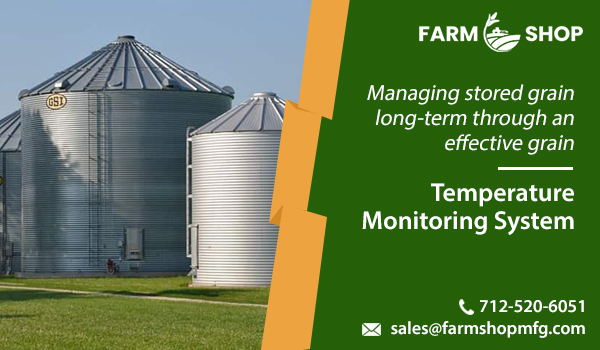Managing stored grain long-term through an effective grain temperature monitoring system
When the harvest of corn and soybeans is delayed especially across the midwestern region of the U.S. then it can raise concerns about the quality of the grain. Besides, another concern is how well you can store the crop effectively for the long term. The commercial grain facilities sometimes end up in outdoor piles of grain. Managing the storage of corn and soybeans for the long term in permanent structures is one of the safest methods which includes such as bins, silos, tanks, as well as horizontal sheds. There are various tools available for managing the grains that include coring, controlled aeration, temperature, and moisture monitoring tor an effective grain temperature monitoring system.
Cleaning the storage
Ideally, before putting the grain, the storage structures are cleaned and thoroughly checked for the presence of any insects in Grain Storage Equipment, aeration ducts, under perforated floors, etc. Along with this, there is a need to check for residual grain inside the bin and any debris that is found around the facility should be removed immediately before filling with the harvested grain.
Use of approved Insecticides
If you are planning for long-term storage of the corn and soybean in the next summer or beyond that period, then it is suggested to use an approved residual insecticide that must be sprayed on the inside walls as well as the floor of the structure. The insecticide should be applied at the external wall surfaces up to about 6 ft (1.80 m) from the foundation. Often the foundation including cracks and crevices, so these areas should not be spared from the application of insecticide. Moreover, areas such as the aeration fan inlets, and conveying equipment outlets must also be sprayed in advance before you plan for the warm weather storage period. The use of insecticide will prevent insect infestation or causing any harm to the grain. Generally, the grain protectants such as insecticides are not required on cold and dry grain that is carried into the warmer months of the year except for applying the grain protectors on the grain mass surface.
Weather
It is suggested that the outdoor piles of the grains must be picked up before the weather turns warm and humid during the months of April or May. If in case, the Corn is kept in outdoor piles for a longer period of time, then the moisture content must be closer to 13% for maintaining its shelf life as well as reducing any sort of damage that may occur due to mold, insect, pest, etc. If the corn that is kept outside is not managed properly, then the levels of damage to the corn in outdoor piles can extend easily upto 30% to 40%. Similarly, if the soybeans are not piled on the ground the damage can be prevented to a great extent.
Moisture content concerns
Delayed harvest of the grains such as corn and soybean can result in higher moisture content than normal in the fields of corn and soybean. In the case of soybeans, sometimes the availability of moisture content in the soybean is as high as 16% has been noticed. Similarly, the moisture content of corn for storing is noticed to be 19%. In such conditions, corn and soybean need to be dried well in advance and they may require heating through air drying. The process of air drying is applied if the grains are harvested late in the seasons of the year. The maximum suggested air drying temperature when it comes to commercial soybeans drying is about 130°F (i.e. 55°C).
Sometimes, it is noticed that after maintaining an effective grain temperature monitoring system wherein the moisture of the grains is ideally sustained at 20% to 90% but you may notice that, there are chances of skins getting cracked. This usually happens if the drying air relative humidity is found to be at 30% or less. When there are moldy and sprouted soybean kernels, it becomes a topic of additional concern. In such a scenario, the moisture content of the soybean must ideally be reduced by not more than 1 to 2 percentage points below the ideal safe storage level of 13%.
However, in the case of storing the corn, there are possibilities of the development of mold-damaged ears or the occurrence of mycotoxins. When there are corn is damaged by mold then it should be dried in high-temperature dryers using EndZone Fan Controls. This is required because the heated air is helpful for the surface-sterilization of the kernels. Moreover, it will reduce the chances of the development of mold during storage, provided that as long as moisture content is reduced at least by 1 to 2 percentage points below the ideal safe storage level of 15%.
.png)